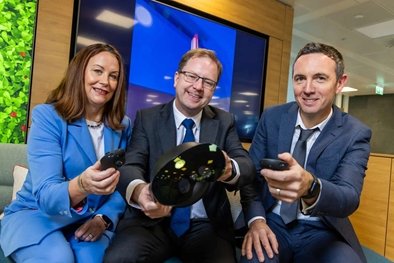From leading the charge on 5G Standalone and satellite technology, to building strategic partnerships, Vodafone is not just adapting to digital transformation, but paving the way for resilient, high-performance networks that keep everyone connected.
And our Group Director of Network Strategy and Engineering, Nadia Benabdallah, has been there from the start.
Joining Vodafone Italy initially, Nadia helped build our 3G network. She has since gone on to play a vital role in developing our 4G and 5G technology and consolidated all the engineering departments into one team of 3,500 people serving Vodafone’s footprint.
We caught up with her to talk about our evolving 5G network, network automation and the other ways in which we’re creating a future-ready network that meets the growing needs of our customers.
Hi Nadia, thanks so much for joining us today. To get us started, can you share an overview of Vodafone’s network strategy?
Our network strategy centres around three key priorities. First, we’re focused on delivering the best possible customer experience by building a future-ready mobile network. That means evolving towards 5G Advanced technology, scaling new network architecture, such as Open RAN, and accelerating the evolution of 5G Standalone—alongside enabling advanced capabilities like network slicing to ensure long-term performance, flexibility, and innovation readiness.
Second, we’re driving efficiency and simplification through automation and reduced legacy infrastructure, supported by compliant, streamlined lifecycle management. This helps us scale operations, cut complexity, and unlock profitable growth.
Third, we’re committed to customer-centric innovation. We’re exploring technologies like satellite to improve coverage, 5G Standalone slicing to improve network quality, and RAN Reduced Capability (RedCap) to optimise the network for low powered devices, bringing a wealth of new services to our customers. At the same time, we’re moving towards zero-touch, Quality of Experience (QoE) driven operations powered by automation, analytics, and GenAI.
What are the main challenges in transitioning between mobile network generations, like from 3G to 4G? And does 5G bring any new challenges that we haven’t faced before?
Transitioning between mobile network generations is a complex process that requires careful planning and coordination. Key challenges include maintaining the current network, reallocating spectrum (changing how radio frequencies are assigned or used), and upgrading infrastructure, all while ensuring uninterrupted service.
Each generation brings new technologies and standards, demanding significant investment and close collaboration across the ecosystem. With 5G we have the opportunity to get further benefits from edge computing, network slicing, L4S (Low Latency, Low Loss and Scalable Throughput) and RedCap, which will provide ultra-low latency, enhancement in congestion management and optimise IoT connectivity
These advancements require smarter, more automated network management to deliver on their promise.
Is there greater potential for 5G to enhance the customer experience?
5G is just the beginning. It’s already delivering real-world benefits, from faster response times to massive Internet of Things support.
At Vodafone, we’re going further, using AI, edge computing, and personalised services to make networks more adaptive and efficient.
These innovations are opening the door to immersive experiences like augmented reality, real-time automation, and intelligent digital assistants, making connectivity more dynamic and tailored to our customers’ needs.
You’ve spoken about network automation, what is it and how will it improve customer experience?
Network automation is at the heart of our vision to create a self-driving, self-healing network.
One that can anticipate issues, adapt in real-time, and fix itself without manual intervention.
We’re using advanced technologies like intent-based services, network abstraction, and API-driven design to make our network fully programmable and orchestrated. This means our engineers can build and scale automation solutions that can transform how we deliver connectivity.
Instead of manually configuring services, we’re moving to a model where we define the intent -like required speed, reliability, or latency - and the network automatically delivers it. Think of it as setting the destination and letting the network figure out the best route.
With near real-time analytics, we can spot potential issues before they impact customers and take proactive steps to maintain service quality. This predictive approach helps us guarantee the experience we’ve promised.
We’re also introducing differentiated service levels, with automated resilience built in, tailored to each customer’s specific needs. And through our Network-as-a-Service model, customers will be able to access and manage services on demand via a self-service portal.
In short, network automation means faster, smarter, and more reliable connectivity, designed around what our customers need, when they need it.
Stay tuned for part two!
In the next part of our chat with Nadia, we look at what’s coming over the horizon—from satellite-to-mobile innovation and quantum-safe networks to early thinking around 6G. Nadia breaks down how Vodafone is exploring new frontiers to keep people connected in more places, more securely, and more reliably than ever.
Want to know more?
Learn more about our Mobile & Fixed networks.
Explore what 5GSA is and how it benefits businesses and customers.



























